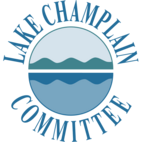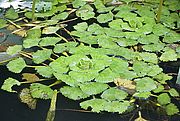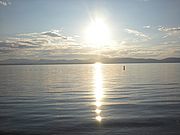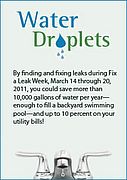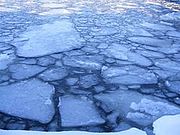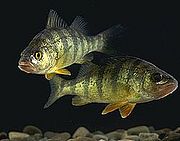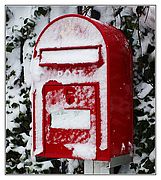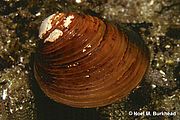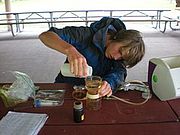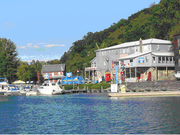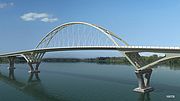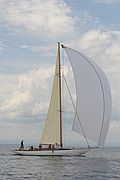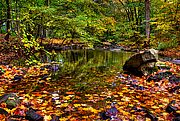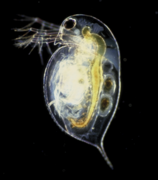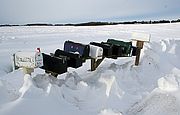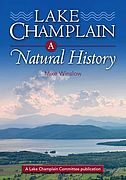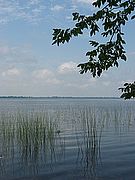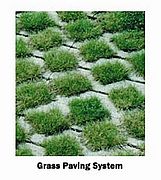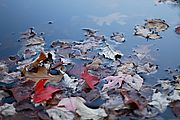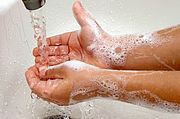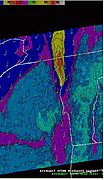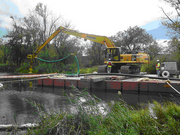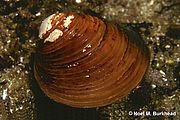The Lake Champlain Committee and environmental consulting firm Arrowwood Environmental have won a competitive grant from the Lake Champlain Basin Program to conduct an invasive species survey of Missisquoi Bay. In recent years, Missisquoi Bay has been the site of a number of new invasions. In 2005 water chestnut (Trapa natans) was found in the Misssisquoi National Wildlife Refuge. In 2009 variable- leaved water milfoil (Myriophyllum heterophyllum) was discovered. Variable-leaved water milfoil has not been seen in the Quebec portion of Missisquoi Bay, but surveys in 2010 left some ambiguity regarding the magnitude of the infestation in the United States portion... Read...
News from Selected Month
A new version of Opportunities for Action has been released. Opportunities for Action is the management plan that guides how federal and state resources are spent to protect and restore Lake Champlain. Regular revisions to Opportunities for Action are required under the Lake Champlain Special Designation Act that provides much of the funding for work on the lake. The newest version, released in December 2010, represents the third edition of the plan... Read...
LCC has been awarded a pollution prevention grant in the most recent round of competitive funding from the Lake Champlain Basin Program. LCC will conduct a water conservation education and outreach program working with multiple partners and in multiple venues to improve water quality in Lake Champlain. Preventing excess water use reduces treatment costs at waste water treatment facilities, increases treatment efficiency, and saves energy... Read...
Throughout the country municipalities and states have struggled over what to do with old or unneeded pharmaceuticals. Too often, they are simply flushed down the toilet, but sewage treatment plants aren’t necessarily equipped to remove them. As a result, the drugs end up in the water where they are still active. Additionally, unused medications often end up on the street, being sold illicitly... Read...
If you’re a skilled carpenter with time on your hands we could use your help! LCC is looking for several volunteers to tackle an interior job building walls and work counters for our office space. The project work will likely take place late winter through early spring. Interested individuals should contact LCC Executive Director Lori Fisher at lorif@lakechamplaincommittee.org or 802 658-1414. Read...
Winter often offers a frozen lake for skating, fishing, and myriad other activities. Throughout the winter you can watch for changes in the ice as it continues to grow, shrink, and move. Three phenomena that demonstrate the dynamic nature of ice are tension cracks, pressure ridges, and ice ramparts... Read...
Take a deep breath. In. Your lungs fill with cool, oxygen rich air. Out. The exhaled air has less oxygen, more carbon dioxide. The average adult at rest breathes twelve times per minute, all for the purpose of exchanging gases in the lungs, to bring oxygen to our blood cells. Fish need the same oxygen, but it is much more difficult to get from water. Respiration is the process by which gases are exchanged between the body and the outside environment. Respiration has two principal components: breathing or ventilation – the movement of an external medium (air or water), and gas exchange – the trade of oxygen and carbon dioxide between blood and that medium. Both ventilation and gas exchange are more difficult in water than in air... Read...
Let us know if there is anyone whom you think would enjoy getting our Ripples E-News bulletins and please, forward it on to colleagues, friends, and relatives that share your love of the lake. We welcome your comments and suggestions for topics to include in future issues. Click here to send us your feedback. Thanks! Read...
If you’ve had an address change recently, please send us an email so we can update your files and ensure you receive news on lake issues and LCC’s work. Our primary form of communication with members is through email. By mailing electronically we save time and resources and reinforce the stewardship ethic of our mission. We don’t give away or sell email addresses. To ensure that our email messages get through to your inbox, please add lcc@lakechamplaincommittee.org and the domain enews.lakechamplaincommittee.org to your safe/allowed list and address book. Thanks! Read...
Do you keep Lake Champlain in your heart through the year? LCC Staff Scientist Mike Winslow puts a Lake Champlain twist on Charles Dicken's 'A Christmas Carol'. Now you can hear him read his piece and see how the ghosts of the lake - Past, Present, and Future - helped change Ebenezer's outlook. Thanks to LCC member Greg Epler-Wood for his recording and sound editing efforts. Read...
The Rensselaer Polytechnic Institute Darrin Fresh Water Institute (DFWI) is leading a pilot project to assess the effectiveness of benthic barrier mats in controlling Asian clam (Corbicula fluminea), the newest aquatic invasive species in Lake George, NY. The pilot project is advised by the Asian Clam Rapid Response Task Force. Partners include technical experts from Lake Tahoe where spread prevention techniques for Asian clam are already underway. Read...
The Burlington Free Press reported that researchers from the University of Vermont (UVM) are conducting the first survey since the 1930s of lake whitefish populations in Lake Champlain, and the results have been promising. Whitefish are relatives of trout and salmon. Lake Champlain is near the southern edge of their habitat range. Up until the early 1900’s there was a strong commercial fishery for the species. However, declines in the quantity of fish taken led to closing the commercial market. When the UVM researchers surveyed historic spawning grounds in Missisquoi Bay and at Larrabees Point in Shoreham, they found no whitefish. Instead the fish seem to be spawning all throughout the Main Lake. Read...
Results from the Lake Champlain Committee's volunteer water monitoring program provide insight into the levels and locations of nutrient pollution. In 2010, significant algae blooms developed early during a July heat wave. Evidence of the bloom was reported from Burlington south to Port Henry, areas not usually associated with bloom conditions. These blooms cleared by mid-July. St. Albans Bay developed a bloom that persisted through much of July and into August. Blooms in Missisquoi Bay were less severe than in recent years and for the first time since 2007 no ‘high alerts’ (worrisome levels of actual toxins measured) were issued. Read...
The New York State Public Service Commission (PSC) conducted a series of public hearings about the proposal to place a cable underneath Lake Champlain to transport electricity to New York City. LCC testified about concerns regarding impacts to the lake and the overall need for the project. The PSC plans to hold evidentiary hearings in early 2011. LCC has applied for active party status in the case. The power line proposers must begin construction by fall of 2011 in order to qualify for federal loans. Read...
It was November of 2009 when the Champlain Bridge was suddenly closed for good due to structural weaknesses in the bridge supports. One year later the bridge is gone; destroyed in a controlled explosion last December. Debris from the original bridge has been removed from the lake, and construction has begun on a new bridge with an anticipated completion date of September 2011. According to the New York State DOT website, since early November, the construction activities at the site have focused on installing the bridge substructures, with work at all 7 piers and both abutments well underway. Fabrication of the steel bridge members is also progressing at a steel fabrication plant in Pennsylvania. The new bridge is being built by Flatiron Construction, a transportation construction and civil engineering firm based in Colorado. In the meantime, a ferry runs 24 hours per day transporting vehicles over the narrow stretch of Lake Champlain the bridge once traversed. Read...
LCC received a $1,500 gift from our friends at the Regatta for Lake Champlain. Established in 2004, the Regatta is a fun annual sailing event that raises funds to support organizations working to promote the health, well-being and sustainable use of Lake Champlain. Over the years, donations from the Regatta have helped fund LCC’s blue green algae monitoring program, maintain the Lake Champlain Paddlers’ Trail, and expand our stewardship efforts. Read...
Autmn’s panoply of colors blankets the mountains of the Champlain Valley. All summer the trees have been investing in short-term high-yield leaves to collect sunlight, and then placing the dividends in long-term wood. Now, they’re dumping their investment before the inevitable downturn, knowing that winter’s snow and winds would be more likely to pull down good wood if they tried to hold onto their leaves. Many of those leaves will end-up in headwater streams of Lake Champlain where they represent the primary energy input for the river system. Read...
On Lake Champlain we have become accustomed to winters when the lake no longer freezes over completely. From the mid 1800s, the time of the first available records, until the 1950s it was almost a given that the lake would freeze over each year. Since then, on average the lake freezes every other year. However, on many lakes freeze over is still a regular occurrence, and a recent report from Germany suggests that when lakes that regularly freeze do not, the results can be dramatic. Read...
If you’ve had an address change recently, please send us an email so we can correct your files and ensure that we keep you updated on lake issues and LCC’s work. LCC’s primary form of communication with members is through email. By mailing electronically we save time and resources and reinforce the stewardship ethic of our mission. We don’t give away or sell email addresses. To ensure that our email messages get through to your inbox, please add lcc@lakechamplaincommittee.org and the domain enews.lakechamplaincommittee.org to your safe/allowed list and address book. Read...
This Sunday, October 10, you can be part of a global work party of grassroots efforts to implement climate solutions. The idea initiated from climate crusader, international environmental activist author, and Champlain Valley resident Bill McKibben through 350.org. From conducting energy audits and planting community gardens to installing CFL light bulbs and lobbying Congress, citizens are getting to work... Read...
What happens to all the leaves that fall into the Champlain Valley’s rivers during autumn as they make their way to Lake Champlain? Why does a thin line of clouds appear over the lake on crisp October days? Why do you sometimes notice a stale rotten smell around the lake in late autumn?... Read...
The International Joint Commission (IJC) will hold two public meetings to discuss progress on identifying important land areas contributing to the pollution of Missisquoi Bay. The meetings will be October 12th in Swanton at the Village Municipal Complex (120 First Street) from 7:00 – 9:30 PM starting at 7PM and October 13th in St. Armand at the Community Center (444 Chemin Bradlee) from 6:00 – 8:30 PM... Read...
Some of the water quality problems that plague Lake Champlain, begin in our own backyards. Find out what you can do to reduce pollutant loading from your property at a free public workshop focusing on... Read...
October is usually the month when Lake Champlain reaches its lowest levels. The average lake level for October is 95.03 feet. Water evaporates throughout the heat of the summer. When plants are growing they transpire water through their leaves leaving less to go into rivers and streams... Read...
The presence of pharmaceuticals and other “new generation” contaminants in surface waters of the United States has been well documented. In Lake Champlain, for example, researchers have found caffeine, HHCB (a musk fragrance), metolachlor (an herbicide). Effects are not well known... Read...
On October 31, 2009 winds buffeted the Champlain Valley stirring the leaves of Halloween. The winds were sustained over a twelve hour period. The next day, the Plattsburgh Press Republican reported wind damage from throughout Essex and Clinton Counties. The cause of the winds was a low-level jet that had developed over Lake Champlain... Read...
Landlocked Atlantic salmon head from Lake Champlain into tributaries to spawn during the fall. The main run of salmon usually extends from early September into mid-November... Read...
The underwater cap at the Burlington Barge Canal Superfund Site is being repaired to ensure that contaminants don’t migrate to Lake Champlain. The $3.5 million sand and silt cap, originally installed during 2003 and 2004, has been largely effective... Read...
The presence of a new exotic species, Asian clam, has been confirmed in Lake George, NY. Lake George drains directly to Lake Champlain via the LaChute River. The thumbnail-sized Asian clam, blamed for clouding Lake Tahoe in the High Sierras... Read...
New York State has passed a bill regulating the use of phosphorus by homeowners. As of January 1, 2012, homeowners and landscape contractors will not be able to apply fertilizer containing phosphorus to their lawns in the absence of a soil test that demonstrates a need for phosphorus or if a new lawn is being established. LCC recommends always getting a soil test...
